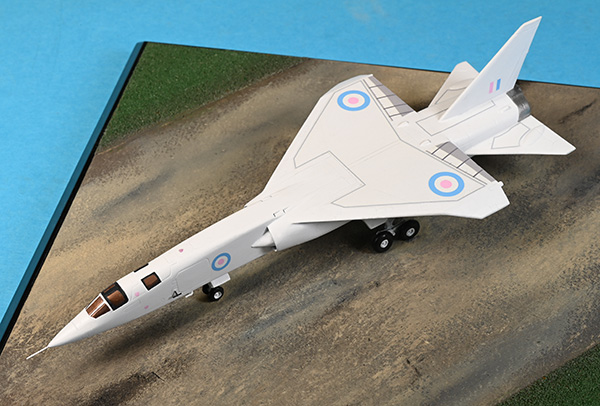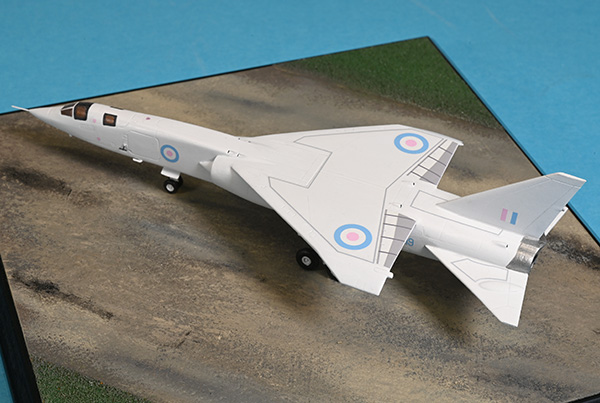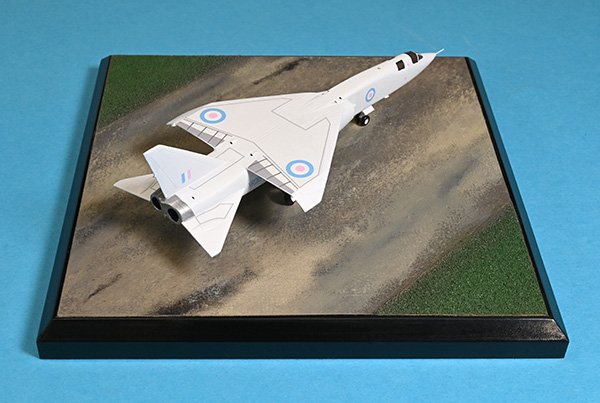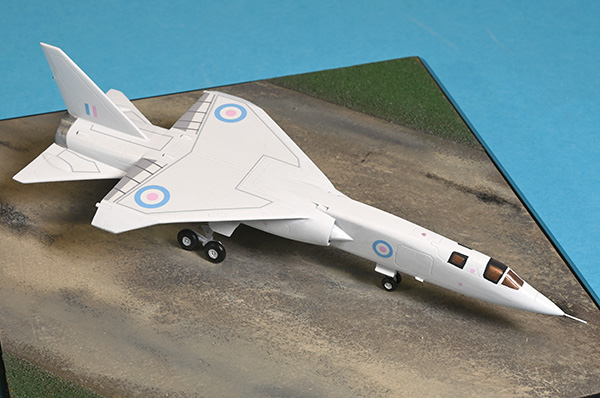BAC TSR 2
BAC TSR-2 XR219 First Prototype,
Boscombe Down, September 1961.
The British Aircraft Corporation TSR-2 (for “tactical strike and reconnaissance 2”) was designed as a Cold War strike and reconnaissance aircraft developed by the British Aircraft Corporation (BAC) for the Royal Air Force (RAF) in the late 1950s and early 1960s. The TSR-2 was designed to penetrate a well-defended forward battle area at low altitudes and very high speeds, and then attack high-value targets in the rear with nuclear or conventional weapons. Another intended combat role was to provide high-altitude, high-speed stand-off, side-looking radar and photographic imagery and signals intelligence, aerial reconnaissance. Only one airframe flew (XR219) and test flights and weight-rise during design indicated that the aircraft would be unable to meet its original stringent design specifications. The design specifications were reduced as the result of flight testing.
The TSR-2 was the victim of ever-rising costs and inter-service squabbling over Britain’s future defence needs, which together led to the controversial decision in 1965 to scrap the program. It was decided to order an adapted version of the General Dynamics F-111 instead, but that decision was later rescinded as costs and development times increased. The replacements included the Blackburn Buccaneer and McDonnell Douglas F-4 Phantom II, both of which had previously been considered and rejected early in the TSR-2 procurement process. Eventually, the smaller swing-wing Panavia Tornado was developed and adopted by a European consortium to fulfil broadly similar requirements to the TSR-2.
Despite the increasing costs (which were inevitable, given the low original estimates), the first two of the development batch aircraft were completed. Engine development and undercarriage problems led to delays for the first flight which meant that the TSR-2 missed the opportunity to be displayed to the public at that year’s Farnborough Airshow. In the days leading up to the testing, Denis Healey, the Opposition defence spokesman, had criticised the aircraft saying that by the time it was introduced it would face “new anti-aircraft” missiles that would shoot it down making it prohibitively expensive at £16 million per aircraft (on the basis of only 30 ordered).
Test pilot Roland Beamont finally made the first flight in XR219 from the Aeroplane and Armament Experimental Establishment (A&AEE) at Boscombe Down, Wiltshire, on 27 September 1964. Initial flight tests were all performed with the undercarriage down and engine power strictly controlled—with limits of 250 kn (290 mph; 460 km/h) and 10,000 ft (3,000 m) on the first (15-minute) flight. Shortly after takeoff on XR219’s second flight, vibration from a fuel pump at the resonant frequency of the human eyeball caused the pilot to throttle back one engine to avoid momentary loss of vision.
Only on the 10th test flight was the landing gear successfully retracted—problems preventing this on previous occasions, but serious vibration problems on landing persisted throughout the flight testing program. The first supersonic test flight (Flight 14) was achieved on the transfer from A&AEE, Boscombe Down, to BAC Warton. During the flight, the aircraft achieved Mach 1 on dry power only (supercruise). Following this, Beamont lit a single reheat unit only (because of problems with the other engine’s reheat fuel pump), with the result that the aircraft accelerated away from the chase Lightning flown by Wing Commander James “Jimmy” Dell, who had to catch up using reheat on both engines. On flying the TSR-2 himself, Dell described the prototype as handling “like a big Lightning”.
Over a period of six months, a total of 24 test flights were conducted. Most of the complex electronics were not fitted to the first aircraft, so these flights were all concerned with the basic flying qualities of the aircraft which, according to the test pilots involved, were outstanding. Speeds of Mach 1.12 and sustained low-level flights down to 200 ft (above the Pennines) were achieved. Undercarriage vibration problems continued, however, and only in the final few flights, when XR219 was fitted with additional tie-struts on the already complex landing gear, was there a significant reduction in them. The last test flight took place on 31 March 1965. Although the test flying program was not completed and the TSR-2 was undergoing typical design and systems modifications reflective of its sophisticated configuration it was regarded by those who flew it as groundbreaking.
Costs continued to rise, which led to concerns at both company and government upper management levels, and the aircraft was also falling short of many of the requirements laid out in OR.343, such as takeoff distance and combat radius. As a cost-saving measure, a reduced specification was agreed upon, notably reductions in combat radius to 650 nmi (750 mi; 1,200 km), the top speed to Mach 1.75 and takeoff run up increased from 1,800 to 3,000 feet (550 to 915 m).
As a consequence of constantly changing government policy, and spiraling costs due to ever changing requirements the decision was taken to cancel TSR-2 was taken and announced on April 6th 1965. For many at the time, and since, this decision has remained highly controversial.
The TSR-2 tooling, jigs and many of the part completed aircraft were all scrapped at Brooklands within six months of the cancellation. Two airframes eventually survived: the complete XR220 at the RAF Museum, Cosford, and the much less complete XR222 at the Imperial War Museum Duxford. The only airframe ever to fly, XR219, along with the completed XR221 and part completed XR223 were taken to Shoeburyness and used as targets to test the vulnerability of a modern airframe and systems to gunfire and shrapnel. Four additional completed airframes, XR224, XR225, XR226 and one incomplete airframe XR227 (X-06,07,08 and 09) were scrapped by R. J. Coley and Son, Hounslow Middlesex. Four further airframe serials XR228 to XR231 were allocated but these aircraft were allegedly not built. Construction of a further 10 aircraft (X-10 to 19) allocated serials XS660 to 669 was started but all partly built airframes were again scrapped by R. J. Coley. The last serial of that batch, XS670 is listed as “cancelled”, as are those of another batch of 50 projected aircraft, XS944 to 995.
Scale 1:144 Wingspan 3.1″ (78.6 mm)
Base size 7.71″ (196 mm) square (No. 5)
Weight not including base 8.8 ozs (249 grams)
Limited edition of 25 only
SOLD OUT





